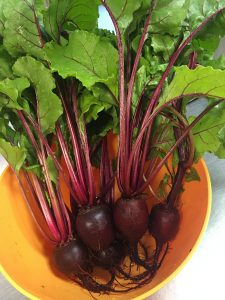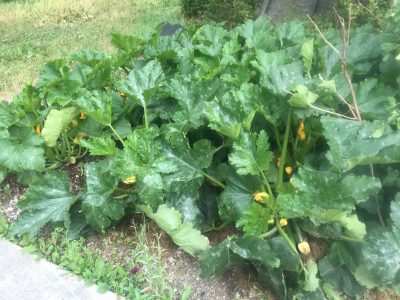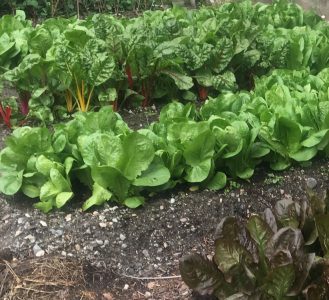Harvest Time!
The last few months have been chalked full of preparation, planting, and weeding and now it is time to harvest the rewards. New gardeners can find it difficult to determine when exactly to harvest each vegetable at the peak of freshness. So I have done some of the research for you and have compiled a list of fifteen vegetables to help you get the most of each vegetable found in a typical Southeast Alaskan garden. Also to make it easier the list is in alphabetical order.
1. Asparagus
Asparagus needs some serious ahead of time planning. It takes a few years to get up and running. A well cared for bed of asparagus will produce spring after spring for 20 to 30 years. Generally begin harvesting asparagus in the 4th year. In the spring the stalks should be as thick as your thumb and about half a foot tall. To harvest the asparagus cut the stalks just above ground level. Cut the asparagus before the tips loosen. Once the tips become loose the stalks become fibrous and tough. Asparagus is quick to grow so check them daily. After harvesting is over asparagus can grow 4 — 6 ft. high. The plant will have light-green lacy foliage. The foliage will yellow in the fall and it is best to cut the yellowing fronds and inch above ground level. Doing this will ensure a bigger asparagus yield the following spring.
2. Beans
Beans are ready to be picked when the pods are small and tender, when the bean seeds are starting to bulge inside the pod. A good rule of thumb is to try and bend the pod, if it snaps crisply it is ready to be picked. The larger the bean pod gets, the tougher it becomes. There are many different varieties of beans yellow bean pods should be fully yellow with no green. Purple pod beans should be without green streaks. To harvest beans pinch the off at the stem. If the bean has a tough time be careful not to pull to hard. A little twist usually does the trick. You can always leave a few pods to dry out in order to keep as seeds for next year or if you are growing beans to be dried.
3. Beets
Mmm! Beets are my absolute favorite! Beets are ready to be pulled out when the top of the beet is visible. The beet should be at least an inch around before you harvest. Bigger varieties of beets can be up to 3 inches in diameter. Leaves should be bright green and younger leaves should be growing out the top of the beet. Beet greens can be picked anytime during the season. Pull out fully mature beets from the soil, dust off the excess dirt and bring it on home. When harvesting and pulling larger beets, be mindful to not disturb the soil around still growing beets.
4. Cabbage
Depending on the variety, cabbage is ready to harvest when the heads develop to expected size. The seed packet or catalog will give you this information. Heads should be firm, not loose. Cabbages need ample room to grow so thinning may be required. Cabbages flavor increases after frost. If a frost is expected, cover the cabbage with a fabric cover. To harvest the heads of cabbage use a sharp knife and cut the head off at the stalk. The outer leaves are usually very fibrous and not so great for eating. You can always add them to your compost!
5. Carrots
Harvesting carrots is one of my favorite time of the season. It amazes me every year how such a tiny seed can become such a big delicious carrot. Carrots are ready to be pulled when their stalks are thick and about a foot talk. The carrots should be anywhere from an inch to an inch and half in diameter at the top of the soil. Carrots come in many varieties and can be anywhere from 2- 9 inches long. Harvest the carrot by pulling from the stalk. The entire carrot should come with the stalk. You can always leave the smaller carrots so they can continue growing.
6. Chard
Chard is used like cabbage or spinach. It is harvested for its shiny green leaves that are great in any salad or as cooked greens. The leaves can be cut any time during the season. Remove the outer leaves by twisting them off from the base or with scissors. Do this gently so as not to pull the entire plant out of the ground. Chard will continue to create new leaves from the base until it is killed by frost.
7. Garlic
Garlic is reliable in Southeast Alaska. Garlic is usually planted in the fall and harvested the following summer when more than half of the leaves have turned yellow. The stalk should still be green. The bulb of the garlic is getting ready to split during this time frame. So it is best to pull the garlic before it begins splitting. Once you pull the garlic cut the roots off. Some people like to braid the tops of the garlic together which can be done with soft neck garlic but not hard neck garlic which is usually grown in Alaska. Hang your garlic in a cool, dry, well ventilated spot.
8. Kale
Kale is a leafy green that can be harvested throughout the growing season as long as the leaves are about 3 inches long. Just like chard, kale will keep producing even after being harvested. To harvest, remove outer leaves and twist off the inner leaves from the stalk. Kale leaves also sweeten with frost. So it is a good idea to plan the main kale harvest after the first light frost. Kale is very hardy and can produce well into winter if kept covered, at least in Southeast Alaska.
9. Lettuce
Lettuce much like Kale and Chard can be harvested throughout the season when the leaves are 3 inches long–until the lettuce begins to bolt and flower. Once the plant has sent its flowering stalk up (bolted), the leaves become very bitter. Harvest the lettuce by taking the outer leaves and leaving the center for leaf lettuce. The center will continue to make new leaves until day length and temperature cause it to flower and seed. For head lettuce, such as butterhead, harvest the entire head. Lettuce tolerates light frosts and can survive well into October in Southeast Alaska..
10. Peas
I love growing peas and watching their tendrils curl and cling. My favorite are snap peas. Snap peas are ready when the pods have filled out with firm, round peas. Snow peas are ready when the immature peas can be seen through the top edge of the pod. Snow pea pods should be flat. To harvest pinch and twist the pods off of the vine. Peas are very sweet upon picking. So prepare or eat them right away. The sugars of the pea turn to starch.
11. Radishes
The fast growing radish is ready for harvest with the bulb can be seen poking above the soil. Radishes are usually about half an inch to an inch around when they are ready for pulling. Pull radishes by the stalks, shake off excess dirt, then wash, chop and add to your favorite salad.
12. Spinach
Spinach is harvested much like lettuce. Take the outer leaves as needed all throughout the growing season. Let the inner leaves continue to grow. Same as lettuce, once the spinach has flowered and seeded, remove the plant by the root and compost as it will be too bitter to eat. Spinach can be replanted in late July or early August for a fall harvest.
13. Summer squash
Flowers of squash must be fertilized so multiple plants are required for a good yield. Squash should be harvested after the flower fades and when the skin is tender. To harvest the squash, cut the stem close to the stalk. Squash is best stored uncovered, at room temperature. Squash stored in the refrigerator will have a tendency to mold.
14. Winter squash
When the color fully develops on the squash, the skin will be firm and ready for harvesting. The skin should be thick enough that a scratch cannot be made with a finger nail. The plant and vines of the squash usually start to die back when the fruit starts to ripen. Cut the squash where the vine meets the stem. Leave the stem on the squash. This helps to prevent the squash for rotting. The skin should be fully hardened before storing.
15. Zucchini
The zucchini forms from the female flowers just like other squash plants. Small zucchini can be cut about a week after flowering occurs. I have found the smaller zucchini’s to be best in stir fries. Larger zucchinis’ are good for baking but any zucchini over a foot long will begin to develop seeds in the middle. Depending on the toughness of the skin it should be removed.
The most important thing I have learned about gardening this year is that timing is everything. Especially here in Southeast Alaska. I have realized the better I manage the timing process of my garden, the higher yields come harvest time. I keep track in a notebook and hopefully next year I will be even more prepared. The best teacher is your own garden.
I picked up these tips along the way but I also use the Internet when I am feeling puzzled. Here are a few helpful links to helping you have a plentiful harvest!
- Recommended Southeast Alaska varieties
- Everything you need to know about my favorite: Beets!
- Recipes for all that leafy green stuff!
- Winter squash
- Summer squash
- Food preservation instructions

Lovely Post Thank You!!!!